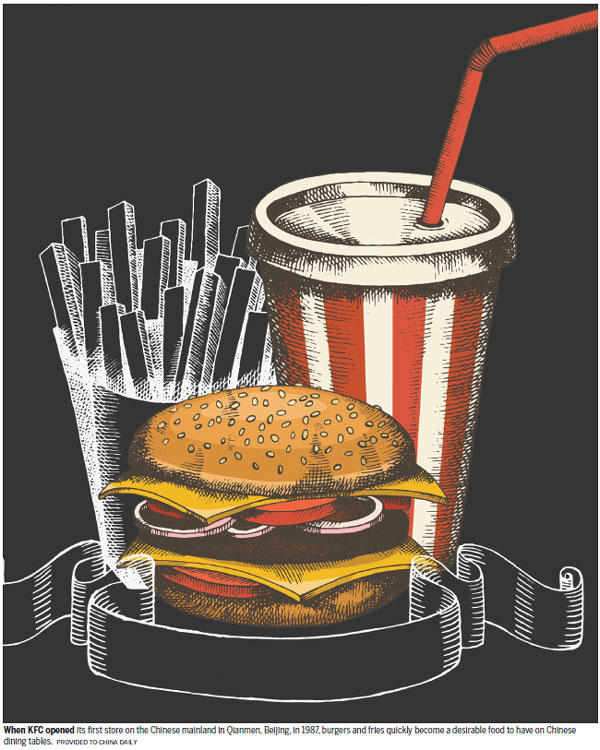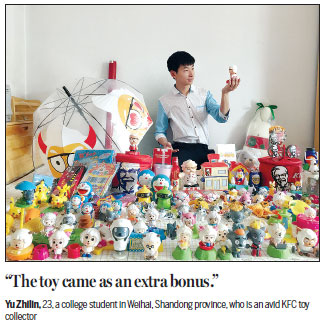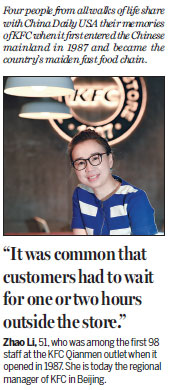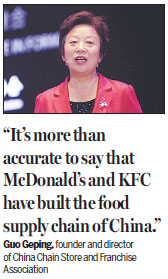From past to present

Once regarded as a lavish treat that not everyone could afford, KFC is today the undisputed leader in the domestic fast food industry, with its famous offerings consumed by millions
Four people from all walks of life share with China Daily USA their memories of KFC when it first entered the Chinese mainland in 1987 and became the country's maiden fast food chain.
How did you end up working at KFC?
I saw the job posting on the only local newspaper and found out the hiring restaurant was just one block away from my home. I had completely no idea what KFC, or fast food, or Western restaurants were as there were no such things back then. My only motivation was the fact that the restaurant was near home and that might be better than the administrative job my family found for me at a hospital.

When I arrived for the interview, which was arranged at a middle school opposite the restaurant, I was shocked. There were so many candidates that I could barely make it past the school gate. And everyone, both male and female, were so attractive. It was more like a casting call for a film.
There was also a height requirement - women had to be above 1.6 meters while and men had to be taller than 1.7 meters. I was later told that only 98 out of the more than 1,000 people would be hired. I waited more than four hours for my turn, but the interview was quick - a self introduction in Chinese and in English, followed by a written examination that required you to translate Chinese numbers into English. That was it.
I was notified two days later and started job training for about three months. Part of the training involved watching a program on a small black and white television about how KFC in the United States operates.
What was the business like when it first opened?
It was an instant hit and we were breaking sales records almost every day. During the first year, our daily turnover peaked at 150,000 yuan ($22,790), an amount no other KFC in the world has achieved even till today despite inflation over the past three decades. It was common that customers had to wait for one or two hours outside the store. Sometimes customers would just tour the store and leave without buying anything because 2.5 yuan for a piece of fried chicken was considered too pricey.
We also had to deal with misconceptions because most Chinese customers had never been to a fast food store before. There were actually people who tried ordering chicken soup noodles or a whole chicken. Some even said they wanted to order "a KFC". There were also people who left the counter after paying and we had to explain to them that KFC was a self-service restaurant.
Was it a big deal to work at KFC since it was so popular?

For the first few years, my family and friends did not know what I was doing. The most common question I was asked was if I fried the chickens at the restaurant. We started with 2 yuan per day and quickly progressed to 5 yuan per day. I guess we were the best-paid cashiers and waitresses in China then.
Starting from the third year of operations, KFC started to recruit again for its second location. Many of those who applied for the job had "special connections" to become a cashier or a waiter.
How has KFC in China changed over the decades?
In 1987, KFC came and offered whatever it had without knowing or caring if the consumers even wanted fried chicken. Today, Chinese consumers are increasingly sophisticated and knowledgeable, and we are making every decision based on large amounts of consumers insights and market data.
How did you become a KFC toy collector?
The first toy I got was by accident. I had been dreaming about having a KFC meal for months after watching its TV commercials. My dream finally came true at the age of 12 when I was rewarded with a KFC meal for getting good grades in school.
The toy came as an extra bonus because I had the Happy Kids' Meal. It was a blue plastic Doraemon that can be remotely controlled by sound. It was so exquisite and fun that I lost interest in many of the other toys that my parents bought for me. I stopped counting the number of KFC toys I own about two years ago - it's just too much work. Back then, the figure exceeded 1,300.
Are you still collecting KFC toys? Why?

Yes, I am still trying to collect as many KFC toys as possible. I think the amount I have now accounts for about one-third of what KFC has introduced in China. When I first started, it was mainly a competition with my peers to see who can get the latest collectible first since having a KFC meal was a very big deal back then. This gradually turned into a hobby and it is thankfully not a very expensive one to have. I think I will keep collecting as long as KFC introduces new toys.
I have never thought about selling my toys, though I know some of them can fetch high prices on online auction platforms. But I always want to set up a space at a kindergarten or primary school in an underprivileged region so that the kids there can play with the toys.
Did you face any problems in collecting these toys?
The early years were difficult mainly because of money and distance. I had to be on my best behavior in order to earn a 20 yuan "KFC fund" from my mom. As I wanted to save on the 5-yuan bus fare, I would walk 40 minutes to and from the only KFC in my hometown. Doing so also allowed me to use the savings to enjoy a secret KFC meal that my mother did not know about.
When I grew older, it was the obsession with getting a complete collection that was tiring. Once, I had five kids' meals and visited all seven outlets in my hometown within a day.
Do you collect other toys?
Yes, I have 500 or so toys from animations and upwards of 300 from McDonald's. But I focus on collecting KFC toys because they came to my hometown first.
What were you doing in China in 1987?
I graduated from university the year before and came to Beijing in May with a friend who was very interested in China and wanted to continue his Chinese studies in Taiwan. I got a job to teach English at a university here so I came back in August and stayed for two years before going to Hong Kong.
Back then, there were no Western food establishments. The only Western food we could get was from joint venture hotels.
I was craving American food and one day someone told me there was a KFC near Tian'anmen, so I went down and saw this massive restaurant that was nothing like the US outlets. It was like a tourist attraction. Today it has become a one-floor restaurant that is nothing like the old one.
What was it like to eat at a KFC in China in 1987?

It was quite special. Most foreigners were getting special treatment at hotels and train stations in China. But at KFC, we had to dine like the average Chinese. We needed to wait in line and I had to spend more than an hour to travel to KFC from the university I taught at. Because of the distance, I only ate at KFC twice a month at most.
I love fried chicken. But I wasn't that into KFC back in the US. There were several chains offering fried chicken where I grew up in Washington DC. I guess most of my KFC quota was filled in China.
How often do you dine at fast food restaurant now?
Almost never. It's interesting. Now, I only go to KFC or McDonald's when I am out of Beijing where I live, or in Chinese cities I am not very familiar with. The food is not very healthy and there are also so many other choices to choose from. But I never worry about food safety issues. I think most of the issues were merely storms in teacups. I personally believe that big chains, including Chinese fast food chains, have a higher food safety standard than the smaller shops along the street.
What do you think makes KFC bigger than McDonald's in China?
KFC arrived five years earlier in Beijing, which is very important. Besides, I think chicken was more "Chinese" than hamburgers during those early days. Chicken is also cheaper than beef here in China and KFC is generally cheaper than McDonald's - this makes it easier for them to penetrate the smaller cities.
Was KFC the first chain restaurant on the Chinese mainland?
Definitely. Before KFC there was no such thing as a chain store. If you told a businessman that you wanted to develop your business into a chain during the 1980s or even early 1990s, they would have no idea what you're talking about. The success of KFC in China has provided a prototype for the country's restaurateurs and other businesses to learn from. Meanwhile, it has also helped to set up benchmarks, standards and even the whole fast food industry.
Traditionally, restaurant businesses in China refer to mom-and-pop shops. The owner sources his ingredients directly from markets, which is still the way many small eateries operate today in the country. But in Japan, a hole-in-the-wall restaurant is backed up by a very strong supply chain. It's more than accurate to say that McDonald's and KFC have built the food supply chain of China and reshaped the landscape of the country's restaurant business.
Do you think KFC and McDonald's have lost their edge in China?
In terms of size, they are still far ahead of other restaurant chains. In the top 100 rankings for the revenue of chain businesses in China in 2016, KFC and McDonald's were the only restaurant brands on the list. KFC was 9th and McDonald's was 26th. Together with Starbucks, the three players account for about one-third of the restaurant chain business in China.
In terms of popularity, the reasons people dine out today could be very different from decades ago. Before, there was only one reason: such foods were a special treat.
Today, the motivations could vary from not wanting to cook to people looking for a social and business meeting location. You could say that KFC and McDonald's have returned to their roots in China -being fast and convenient instead of being a luxurious and exotic dining experience.
xujunqian@chinadaily.com.cn









